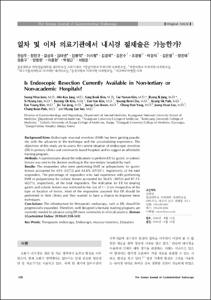KUMEL Repository
1. Journal Papers (연구논문)
1. School of Medicine (의과대학)
Dept. of Internal Medicine (내과학)
일차 및 이차 의료기관에서 내시경 절제술은 가능한가?
- Keimyung Author(s)
- Kim, Eun Soo; Cho, Kwang Bum; Park, Kyung Sik
- Department
- Dept. of Internal Medicine (내과학)
- Journal Title
- Korean Journal of Gastrointestinal Endoscopy
- Issued Date
- 2010
- Volume
- 41
- Issue
- 6
- Abstract
- Background/Aims: Endoscopic mucosal resection (EMR) has been gaining popularity with the advances in the technique and the accumulating experience. The objectives of this study are to assess the current situation of endoscopic resection (ER) in primary clinics and community-based hospitals and to suggest an affordable training program.
Methods: A questionnaire about the indications to perform ER for gastric or colonic lesions was sent to the doctors working in the non-tertiary hospitals by mail.
Results: The responders who were performing EMR or polypectomy for gastric lesions accounted for 43% (31/72) and 44.8% (47/101), respectively, of the total responders. The percentage of responders who had experience with performing EMR or polypectomy for colonic lesions accounted for 56.6% (30/53) and 87.3% (62/71), respectively, of the total responders. The indication for ER for treating gastric and colonic lesions was restricted to the size of 1∼2 cm irrespective of the type or location of lesion. Most of the responders assumed that ER should be performed in their clinics and they wanted to have a chance to improve these techniques.
Conclusions: The infrastructure for therapeutic endoscopy, such as ER, should be progressively expanded. Therefore, well designed schematic training programs are currently needed to advance using ER more commonly in clinical practice.
목적: 내시경점막절제술 및 내시경점막하박리술은 기술적 측면에서 발전을 거듭하면서 현재 위장 및 대장의 조기암이나 전암성 병변의 치료 영역에 널리 쓰이고 있다. 그러나 대부분의 경우 삼차 의료기관에서 시행되는 경우가 많다. 이 연구는 일차 및 이차 의료기관에서 내시경절제술에 대한 현황을 알아보고, 실제 진료에 적용하기 위해 필요한 체계적 교육에 대한 틀을 마련하기 위하여 진행하였다.
대상 및 방법: 대구경북지역 내과, 외과 및 가정의학과 계열 개원의와 봉직의를 대상으로 위 및 대장의 내시경절제술 경험과 적응증에 대한 설문지를 보낸 후 회수하였다.
결과: 총 1,631명 중 112명이 응답하여 수거율은 6.8%였다. 내시경 전문의가 79명으로 75.2%를 차지하였고 내과의가 82명으로 78.1%를 차지하였다. 위 병변에 대한 EMR 또는 용종절제술은 43%(31/112)와 44.8%(47/101)에서 시행하였다. 위 병변에 대한 EMR의 적응증으로는 모양이나 위치에 상관없이 크기가 1∼2 cm일 때 시행하는 경우가 많았다. 대장 병변에 대한 EMR 또는 용종절제술의 경험은 각각 응답자의 56.6%(30/53)와 87.3%(62/71)에서 있었다. 대장 병변에 대한 내시경절제의 적응증 역시 모양이나 위치에 상관없이 크기가 1∼2 cm일 때 시행하는 경우가 많았다. 대부분의 응답자들은 내시경절제술을 일차 및 이차 의료기관에서도 시행하는 것이 좋다고 답하였으며 동물모델 등을 이용한 교육에 적극적으로 참석하겠다는 답변이 많았다.
결론: 내시경절제술과 같은 치료 내시경의 저변을 점진적으로 확대해나가는 것은 필요하다. 이를 위해서는 체계적인 교육과 지속적인 배움의 기회를 제공하는 것이 중요하다.
- Alternative Title
- Is Endoscopic Resection Currently Available in Non-tertiary or Non-academic Hospitals?
- Publisher
- School of Medicine
- Citation
- 전성우 et al. (2010). 일차 및 이차 의료기관에서 내시경 절제술은 가능한가? Korean Journal of Gastrointestinal Endoscopy, 41(6), 338–343.
- Type
- Article
- ISSN
- 1225-7001
- Appears in Collections:
- 1. School of Medicine (의과대학) > Dept. of Internal Medicine (내과학)
- 파일 목록
-
-
Download
 oak-bbb-2274.pdf
기타 데이터 / 522.09 kB / Adobe PDF
oak-bbb-2274.pdf
기타 데이터 / 522.09 kB / Adobe PDF
-
Items in Repository are protected by copyright, with all rights reserved, unless otherwise indicated.